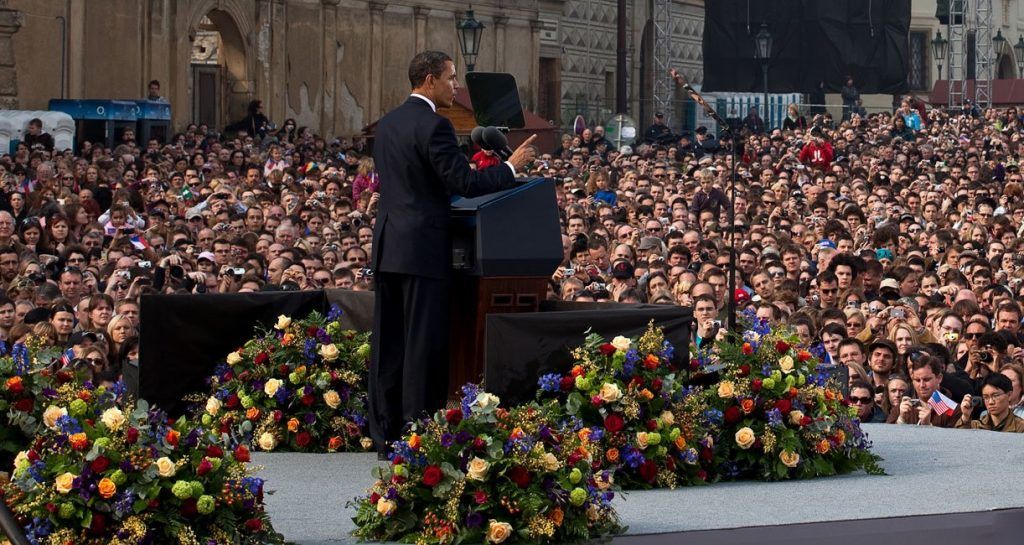Obama’s nuclear legacy on the line
By Kingston Reif | February 27, 2014

For all the well-justified praise US President Barack Obama has received for his efforts to roll back the Iranian nuclear threat, the rest of his nuclear security agenda has stalled.
Obama famously proposed an ambitious nuclear risk-reduction program in a speech in Prague at the beginning of his first term, and followed it up with a number of early achievements. He reiterated the importance of his agenda in a June 2013 speech in Berlin, but key priorities remain incomplete while others have scarcely gotten off the ground.
To be sure, blame for the hold up is hardly the president’s alone. It stems in large part from forces beyond his control, like Russian resistance to further arms control measures and domestic political obstruction by Republicans. And Iran has no doubt consumed much of the nonproliferation oxygen. But a lack of White House attention and an overabundance of caution have also played a role, and if no additional progress is made, Obama’s triumphs will not compare favorably to the bold proposals he outlined in 2009. There are steps the administration can take during the remainder of Obama’s time in office to breathe new life into his agenda, increase US security, and set the stage for future progress.
A mixed record after early progress. In his first term, Obama issued a Nuclear Posture Review that reduced the role of nuclear weapons in US policy; signed the New Strategic Arms Reduction Treaty (New START), reducing the US and Russian deployed nuclear arsenals; and spearheaded an historic international effort to prevent nuclear terrorism and elevate it to an issue of concern for heads of state—the results of which include the removal of all highly enriched uranium from 12 countries, including Ukraine.
Yet despite these notable successes, there has not been forward movement in other areas of the Prague agenda. For example, the administration postponed plans to seek a Senate vote on the Comprehensive Test Ban Treaty, which prohibits all nuclear test explosions. Though Obama restated the importance of the treaty in Berlin in June 2013, the administration has so far done little to build support for it.
The second-term nuclear cupboard has not been entirely bare, however. In his speech in Berlin, the president announced that he had signed off on a long-delayed update to high-level nuclear weapons policy guidance, paving the way for a potential reduction in deployed strategic nuclear warheads of up to one third below the New START limit of 1,550. In addition, efforts to safeguard and eliminate nuclear materials have continued, as has the Nuclear Security Summit process, the third installment of which is scheduled to take place in late March 2014 in the Netherlands.
Signing off on the updated nuclear guidance was an important step forward, but instead of taking 90 days to complete as originally planned, it took two years. The president also conditioned further weapons reductions on negotiations with Russia, which may not be forthcoming. Moscow has rejected US appeals to engage in another round of arms reductions and a data-sharing plan to reduce tension over US missile defense plans. Furthermore, the new guidance appears to tie considering reductions in the US force of approximately 2,500 reserve warheads to the implementation of an unaffordable and impossible-to-execute warhead modernization plan.
Despite the gains made to date on nuclear material security, it is unclear whether the administration has crafted a strategy to build on its achievements. Meanwhile, budget cuts over the past two years have contributed to delaying key priorities, such as the target date for converting or shutting down 200 research reactors that use highly enriched uranium around the world, which has slipped by eight years.
Hope on Iran, frustration on North Korea. Much like the rest of his nuclear agenda, Obama’s efforts to address the two greatest threats to the nonproliferation regime have met with mixed results.
The first-step agreement between six nations and Iran, signed in November 2013, was a remarkable achievement. The six-month deal constrains Iran’s nuclear program for the first time in a decade, and provides an opportunity to negotiate a more comprehensive agreement that erects even stronger roadblocks on Iran’s path to a bomb. Were such a deal to be successfully implemented, it would eliminate a great threat and be a legacy-defining feather in the US president’s cap. However, the next round of talks will be enormously challenging. Obama has put the chances of reaching a longer-term agreement at no better than 50 percent.
And then there’s North Korea. For all the recent progress with Iran, North Korea’s nuclear program is moving forward at an alarming rate. Advances over the past 18 months include a successful satellite launch, a third nuclear test, the resumption of plutonium production at the Yongbyon reactor, and steps to deploy long-range ballistic missiles capable of striking the United States. Diplomatic efforts to defuse the threat are in a deep freeze with little evidence of a thaw on the horizon.
Shaping a legacy.While negotiations with Iran will likely remain its top priority, the Obama administration can’t afford to ignore other aspects of nuclear risk reduction.
One of the first orders of business is to secure ratification of two international agreements: the 2005 amendment to the Convention on the Physical Protection of Nuclear Material and the 2005 International Convention on the Suppression of Acts of Nuclear Terrorism. Together these treaties update and strengthen the legal tools available to prevent nuclear terrorism. At the Nuclear Security Summit held in Seoul in March 2012, more than 50 countries, including the United States, pledged to seek the entry into force of the protection of nuclear material amendment in time for the Netherlands summit in March 2013. However, the president cannot ratify these treaties until the US Congress passes implementing legislation to criminalize specific offenses prohibited by the agreements. This legislation has remained stalled in the Senate for the past two years, and the administration must devote far greater attention to breaking the logjam than it has to date.
In 2014 the administration should also begin to accelerate implementation of New START. While the treaty does not require the limits to go into effect until 2018, there is no reason to wait that long, since Russia is already below the warhead and delivery-vehicle limit.
The above priorities should be addressed more or less immediately, but there are other measures the administration ought to also pursue during the remainder of the second term.
As he continues to seek further cuts with Russia, Obama should direct the Pentagon to explore initiatives that do not require the immediate agreement of others, such as increasing transparency about the size and composition of US nuclear forces and reducing the arsenal’s launch-readiness requirements. He also needs to make a much stronger national security case for reshaping our outdated nuclear posture. If Russia continues to stonewall, the administration should not give Moscow a veto over eliminating weapons that the president’s military advisors have already said aren’t needed as part of the nuclear guidance review.
The president should also order an interagency review of current plans to rebuild the nuclear triad of delivery systems—bombers, land-based missiles, and submarine-launched missiles—and their associated warheads, the cost of which could exceed $300 billion over the next quarter century. These plans are likely unaffordable, and it’s unclear why they are required to sustain an effective deterrent. Moreover, by continuing a process—one that began with New START—of tying reductions to unachievable nuclear spending plans, the inevitable failure to execute them will only further weaken congressional support for right-sizing the arsenal.
Finally, while the administration has understandably been loath to recommit to talks with North Korea, following a failed agreement to freeze parts of Pyongyang’s nuclear program in return for food aid, it should. As Stephen Bosworth and Robert Gallucci wrote in 2013, “whatever risks might be associated with new talks, they are less than those that come with doing nothing.”
Obama has professed a deep and serious concern about reducing the danger posed by the potential spread of nuclear weapons, the threat of nuclear terrorism, and the continued existence of bloated arsenals and stockpiles around the world. Legacies are defined by actions, though, not words.
Together, we make the world safer.
The Bulletin elevates expert voices above the noise. But as an independent nonprofit organization, our operations depend on the support of readers like you. Help us continue to deliver quality journalism that holds leaders accountable. Your support of our work at any level is important. In return, we promise our coverage will be understandable, influential, vigilant, solution-oriented, and fair-minded. Together we can make a difference.
Topics: Columnists, Nuclear Weapons














